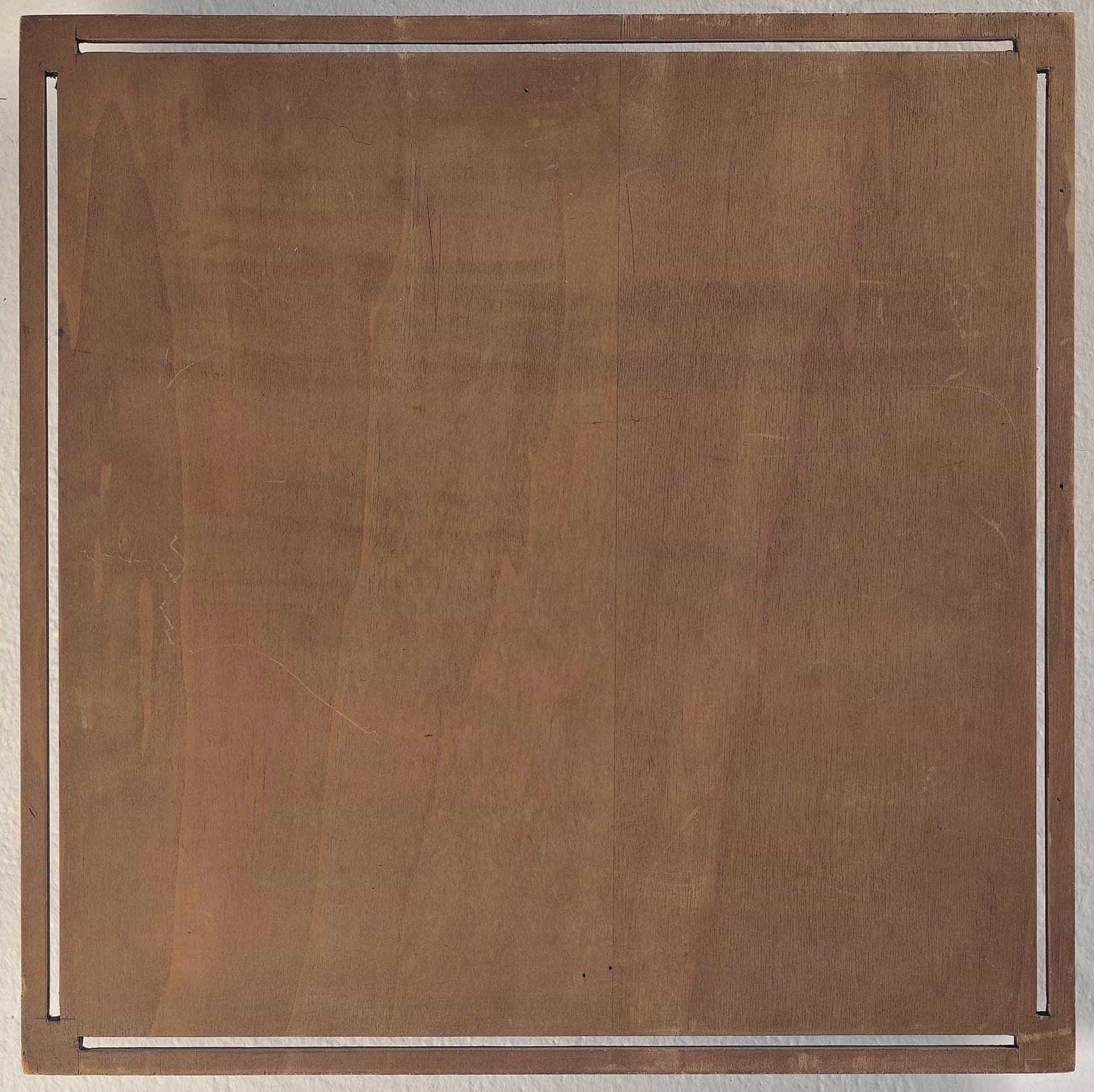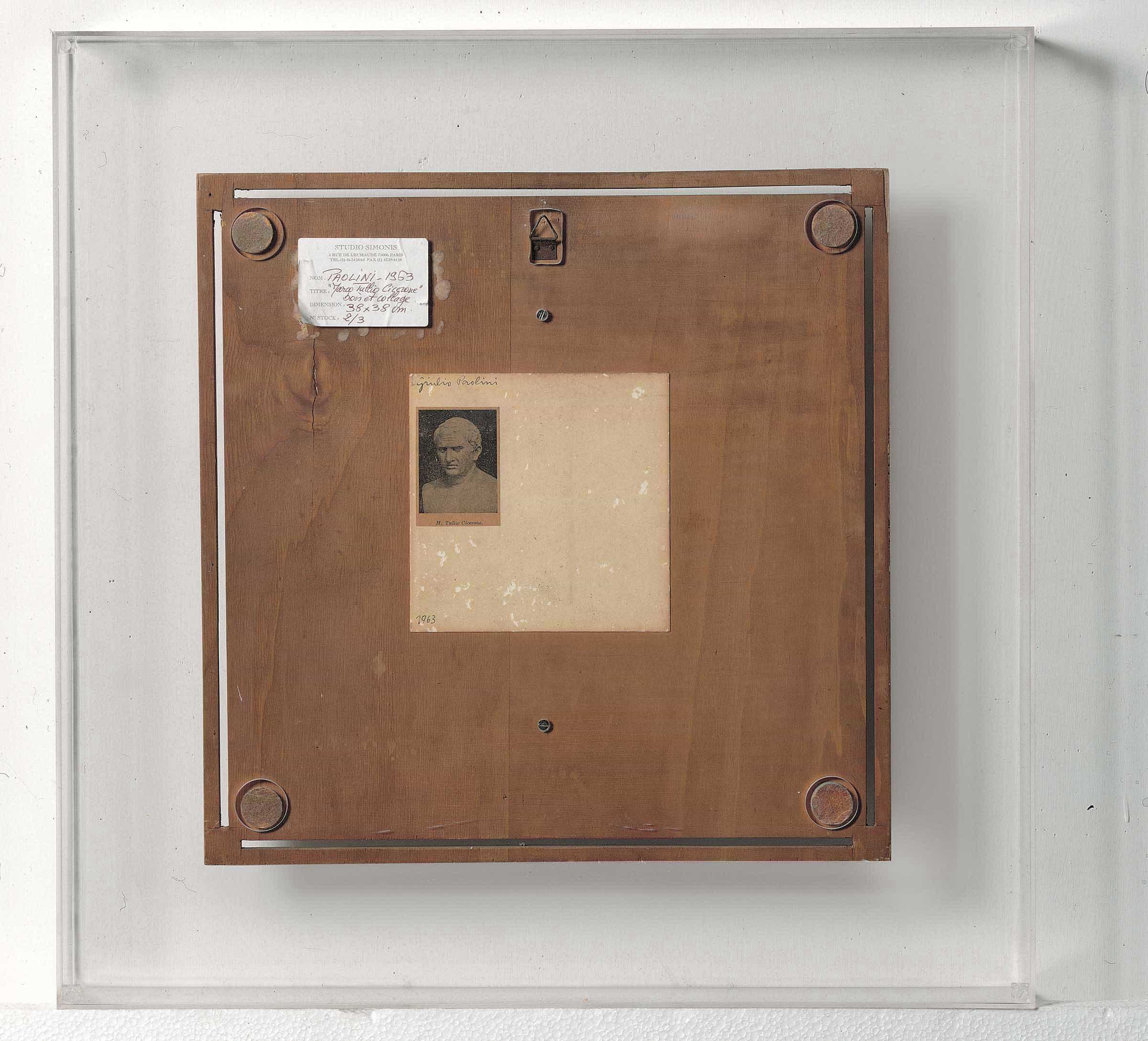M. Tullio Cicerone, 1963
GPO-0049
Perforated plywood panel
40 x 40 cm
Signed and dated on the verso on a white paper square: “Giulio Paolini” (upper left), “1963” (lower left)
Castello di Rivoli Museo d’Arte Contemporanea, Rivoli-Turin. Long-term loan from Private collection
From 4 December 2015 to March 2020 on loan at MASILugano Museo d’arte della Svizzera italiana, Lugano
Four cuts are made along the length of the edges of a plywood panel – the adhesives on the back make it protrude just slightly from the wall – allowing the viewer to glimpse the wall on which it is hung. On the verso is the photographic reproduction of a Roman bust of Cicero, accompanied by the caption on which the title of the work is based.
M. Tullio Cicerone is part of a group of works (from GPO-0028 to GPO-0049) whose common denominator is the presence of an intervention on both the recto and the verso of the painting. Surfaces of various types take turns appearing on the recto (painted paper, graph paper, photographic reproductions, shaped wooden panels), while on the verso (hidden from view) we find the details of images and printed words taken from magazines or from books. The title, when specified, refers to a textual element present on the verso. The artist explains that: “Just as on the surface various elements alternate among themselves, but always remain ‘blind’, in the sense that they tend not to supply an image, but are there for their own sake, occupying that given space, so the title itself is absolutely autonomous with respect to the surface [...], constituted by a fragment of words and, at times, images, following the signature and the date, on a white paper square on the back of the picture” (1972).1
With respect to the other works in this group, M. Tullio Cicerone extends the artist's research to the relationship between the work and the wall on which it is exhibited, foreshadowing the central theme of the artist's output in 1964.
1 G. Paolini in G. Celant, Giulio Paolini (New York: Sonnabend Press, 1972), p. 34 (revised translation, republished in Giulio Paolini 1960-1972, edited by G. Celant (Milan: Fondazione Prada, 2003), p. 122), reprint (Cinisello Balsamo: Silvana Editoriale, 2019), p. 34. Cf. also the artist's remarks in C. Lonzi, Autoritratto (Bari: De Donato Editore, 1969), p. 367, reprint (Milan: Et al./Edizioni, 2010), p. 280, English edition (Brussels-London: Divided Publishing, 2021), p. 320.
| 2022 | Rivoli, Castello di Rivoli Museo d’Arte Contemporanea, exhibited in the Chinese room, from 30 July, as part of the installation of the collection. |
| • | G. Paolini in G. Celant, Giulio Paolini (New York: Sonnabend Press, 1972), pp. 30-31; republished in Giulio Paolini 1960-1972, edited by G. Celant (Milan: Fondazione Prada, 2003), p. 122; reprint (Cinisello Balsamo: Silvana Editoriale, 2019). |
| • | G. Celant, Giulio Paolini (New York: Sonnabend Press, 1972), repr. no. 14 p. 27 (recto, rotated by 180 degrees); reprint (Cinisello Balsamo: Silvana Editoriale, 2019). |
| • | Giulio Paolini (Parma: Università di Parma, Centro Studi e Archivio della Comunicazione, 1976), repr. nos. 23-24 (recto and verso, recto rotated by 180 degrees). |
| • | Giulio Paolini 1960-1972, edited by G. Celant (Milan: Fondazione Prada, 2003), col. repr. pp. 62-63 (recto and verso). |
| • | M. Disch, Giulio Paolini. Catalogo ragionato 1960-1999, vol. 1 (Milan: Skira editore, 2008), cat. no. 49 p. 82, col. repr. (recto and verso). |
| • | I. Bernardi, “Giulio Paolini 1963. Un autore (ancora) sconosciuto”, in Arte italiana 1960-1964. Identità culturale, confronti internazionali, modelli americani, edited by F. Fergonzi and F. Tedeschi, proceedings of the study day promoted by Museo del Novecento and Gallerie d’Italia, Milan, 25 October 2013 (Milan: Scalpendi Editore, 2017), p. 50, repr. no. 7 p. 50. |
| • | Castello di Rivoli Museo d’Arte Contemporanea. La storia e le collezioni, edited by C. Christov-Bakargiev and M. Beccaria, Rivoli, Castello di Rivoli Museo d’Arte Contemporanea (Turin: Umberto Allemandi & C., 2023), vol. II, col. repr. p. 823. |



